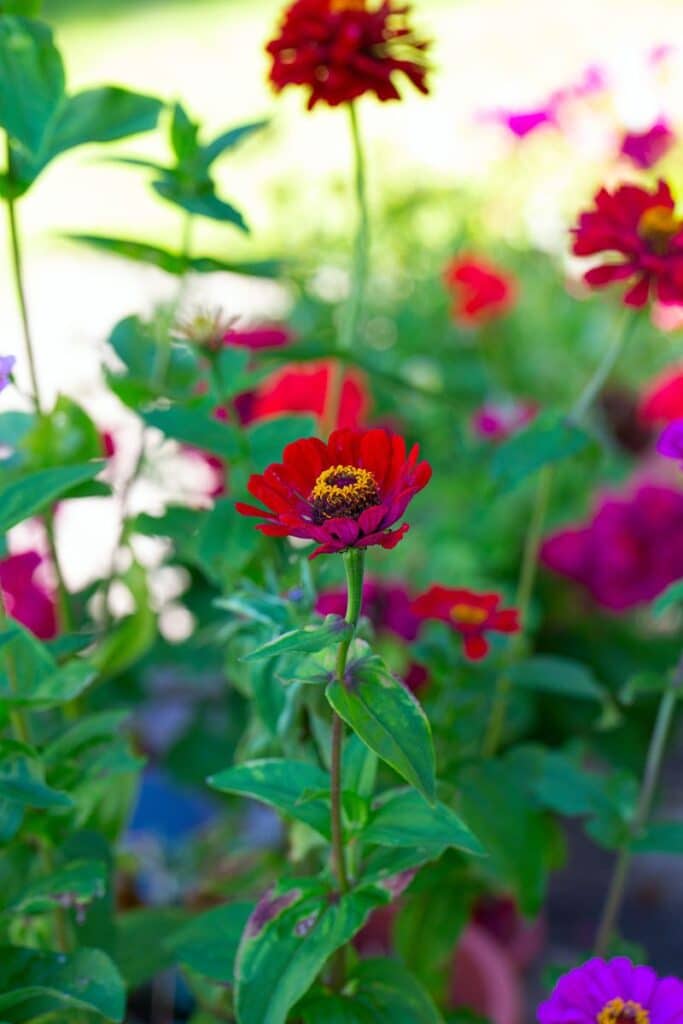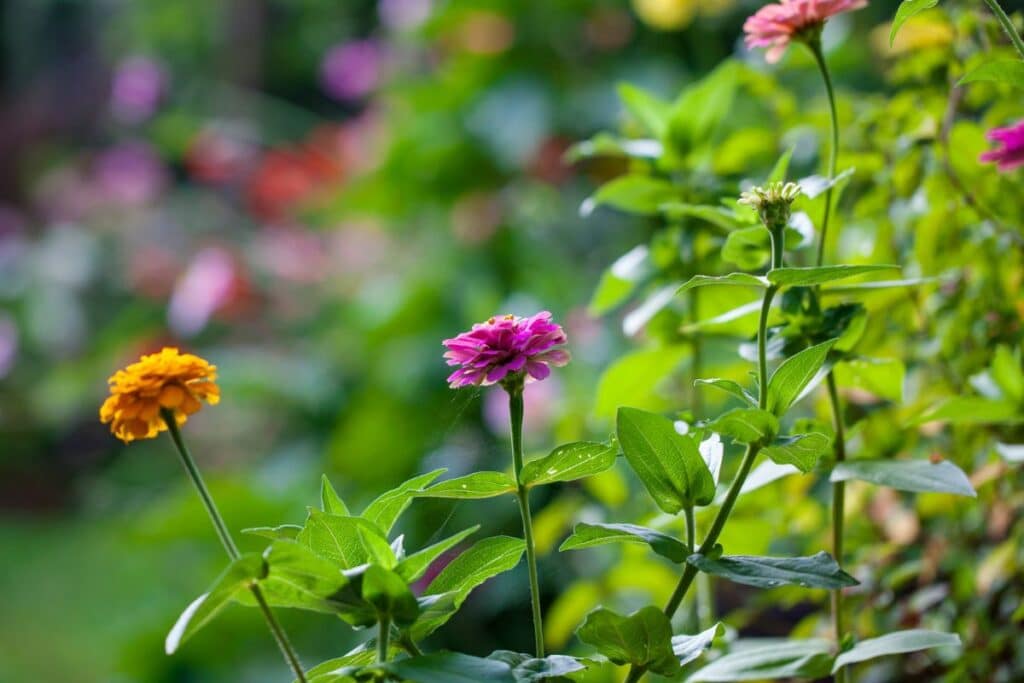Zinnia flowers (Zinnia) are every gardener’s best friend. This is because these flowers aren’t just beautiful, they also offer numerous benefits.
When planting zinnias in your garden, they will attract plenty of pollinators and can help protect other flowers or crops by acting as a trap crop, aiding in pest control. Some of the recommended zinnia companion vegetables are tomatoes, cabbage, cauliflower, and kale.
These beautiful flowers also grow well alongside many other plants. In this guide, we are going to look at the best ways to do companion planting with zinnias so you can get the most benefits from your garden.
What to Plant with Zinnias
It is important to select zinnia companion plants that can grow well in the same USDA zone as zinnias and have the same nutrient, sunlight, and watering needs as these florals.
These annual flowers should be planted in late spring in USDA hardiness zones 3 – 10. They should be grown in direct sunlight in well-drained soil and are relatively drought-tolerant.
- Botanical name – Zinnia
- Height – 6 inches up to 4 feet tall (depending on variety)
- Colors – Pink, red, orange, yellow, peach, and white flowers with vibrant green leaves
- Common zinnia varieties – Big red, California giant, color crackle, crystal white, dahlia mix
- Pairing Benefits – Good for attracting bees, offers lots of aesthetics, acts as a sacrificial crop

Let’s take a quick look at some companion plants that can be grown in these same conditions.
Best Vegetable and Herb Plants to Grow With Zinnias
Zinnias are excellent plants to add to a vegetable garden because they will attract pollinators that can increase your vegetable yields.
They will also protect your vegetables from garden pests because these bright flowers attract beneficial insects like parasitic wasps that feed on common vegetable garden pests.
Here is a quick look at the best vegetable varieties to pair with zinnia seedlings.
Mealy Cup Sage
- Botanical name – Salvia farinacea
- Height – Up to 4 feet tall (1.2 meters)
- Colors – Blue or purple with vivid green leaves
- Pairing Benefits – Repelling pests, attracting beneficial insects, aesthetic appeal
Mealy cup sage (Salvia farinacea), also known as blue salvia or blue sage, is a terrific perennial herb to grow with zinnias because the natural scent of sage can help repel some of the pests that might attack these florals.
These beneficial plants are also good companions because the purple flowers of sage can add lots of texture to your zinnia garden and both of these plants can be harvested so you can create interesting flower arrangements during the growing season.
This low-maintenance plant is pretty easy to pair with zinnia flowers because it is very flexible in terms of soil. This member of the mint family can grow in hardiness zones 7 – 10, they are relatively drought tolerant, and they flourish in direct sunlight.
When you pair these two plants in a flower garden, they will both produce vivid blooms from late spring to late autumn. This will give you a huge explosion of color for almost three seasons.
Members of the Cabbage Family
- Botanical name – Brassicaceae
- Height – 18 – 30 inches tall
- Colors – Green
- Pairing Benefits – Attract pollinators, act as a sacrificial plant to protect vegetable garden
Zinnia flowers have many companions in vegetable gardens and they get along with most members of the cabbage family (Brassicaceae) including cauliflower and kale.
Zinnias can be interplanted with cabbages so these vegetables can benefit from the dappled shade these florals might produce.
But it is better to grow zinnias in rows between cabbages because they will act as a trap crop and will lure pests like aphids and Japanese beetles away from your other plants. These pests will attack your flowers and can leave your edible crops alone.
Cabbages will take well to any well-draining soil and can flourish in direct sunlight which makes them ideal companion plants for zinnias.
Tomatoes
- Botanical name – Solanum Lycopersicum
- Height – 3 – 10 feet tall (1 – 3 meters)
- Colors – Green with red fruits
- Pairing Benefits – Attract pollinators, act as a sacrificial plant to protect vegetable crops
Tomatoes (Solanum Lycopersicum) are often plagued by a huge variety of pests. By growing zinnias close to tomatoes, you can protect your crops because pests like Japanese beetles, aphids, and caterpillars will flock toward the flowers so your tomatoes will be spared.
The zinnia plant will also attract pollinators that can increase your tomato yields.
Both tomatoes and zinnias require lots of direct sunlight and need to be established in high soil quality.
Even though they can grow well in the same garden, it is best to establish them in separate rows. This way, tall tomato varieties won’t deprive zinnias of direct sunlight and it will be easier to remove the zinnias if they become infested with pests.
Best Flowers to Grow with Zinnias
Zinnias are ideal plants for a cutting garden or to add to ornamental gardens because they are so easy to grow, they require little maintenance, and they produce lots of colorful flowers during their extended blooming season.
You can pair zinnias with other flowers to create an even more striking combination or to fill out your garden. Let’s take a quick look at some great companion plants to grow with your beautiful zinnias.
Purple Fountain Grass
- Botanical name – Pennisetum setaceum ruburm
- Height – 2 – 4 feet tall
- Colors – Burgandy foliage with purple foxtail flowers
- Pairing Benefits – Enhances aesthetics
Purple fountain grass (Pennisetum setaceum ruburm) might not be a flower but it is an excellent ornamental grass to grow with zinnias because it will add lots of texture to your garden space.
As with zinnias, this grass variety doesn’t require maintenance and the crimson plumes can add lots of color.
Pairing zinnias and purple fountain grass in the same garden bed is pretty easy because they have a similar growing height and both flourish in direct sunlight.
China Aster
- Botanical name – Callistephus Chinensis
- Height – 8 inches to 4 feet tall
- Colors – White, pink, red, blue, violet, purple, and yellow
- Pairing Benefits – Enhances aesthetics
China Asters (Callistephus chinensis) are terrific zinnia companions because these beautiful flowers create consistent blossoms from summer to fall. When you add these flowers to your summer garden, you will have lots of colorful blooms that can be cut for bouquets and they will help attract bees.
These showy plants can grow well in the same conditions as your zinnias although some species can grow well in partial shade.
You should be careful when selecting a suitable variety. Some varieties of Asters will only grow up to 8 inches tall and should be grown in front of zinnias, while taller varieties can grow up to 4 feet high and are suitable for interplanting in the same garden bed.
Alternatively, you can also pair shorter asters with dwarf zinnias and use them as a border plant.
Dahlia flowers
- Botanical name – Dahlia pinnata
- Height – 1 – 6 feet tall
- Colors – Green foliage with yellow, white, pink, salmon, lavender, orange or purple flowers
- Pairing Benefits – Enhances aesthetics
If you love zinnias then you will likely also love the look of Dahlia plants (Dahlia pinnata). These florals are frequently included when growing zinnias because they also produce lots of vivid blooms that can complement your colorful zinnias all summer long until late fall.
There are many varieties of this beautiful flower and some varieties produce blooms with impressive sizes. These showy plants will give lots of color and are great for filling out your garden bed.
Dahlia flowers can grow well in full sun but sometimes prefer a little bit of dappled shade. These annuals also require good draining soil and need to be watered frequently.
What NOT to Plant with Zinnias
When picking plants to pair with zinnias, gardeners should consider the requirements of each species and ensure that both plants have enough space to grow.
Planting two or three species too close together can cause competition for resources such as water, light, and nutrients. This can result in stunted growth and reduced blooms.
You might want to avoid plants such as peppers, eggplants and potatoes. These bad companion plants produce toxins that can damage zinnia blooms and leaves over time due to cross-contamination through the soil or air.
It’s also important not to pair zinnias with annuals or perennials that share similar preferences in terms of soil quality, pH level or light requirements as these may compete for resources as well.
For example, sunflowers have similar nutrient needs as zinnias so it may be best to keep them separate unless you’re willing to amend your soil accordingly.
FAQs
Do zinnias do better in pots or in the ground?
Zinnias generally thrive better when planted directly in the ground rather than in pots. They prefer well-drained soil, and the unrestricted space in the ground allows their roots to spread, promoting healthier and more vigorous growth.
Are zinnias good in a vegetable garden?
Yes, zinnias can be beneficial in a vegetable garden as they attract pollinators like bees and butterflies, promoting pollination for neighboring vegetables. Additionally, their vibrant blooms add aesthetic appeal, contributing to a visually appealing and diverse garden space.
What is the best support for zinnias?
Zinnias may not require support, as they generally have sturdy stems. However, taller varieties or those planted in areas with strong winds might benefit from staking with bamboo stakes or other supports to prevent bending or breakage. Providing support when necessary helps maintain the upright growth of the plants and ensures the longevity of their vibrant blooms.
Final Thoughts
Zinnias are superb flowers to grow if you want a garden that produces a lot of beautiful blooms. These amazing flowers also offer lots of benefits in vegetable gardens. You can successfully grow zinnias with all sorts of vegetables like tomatoes, cabbages, and asparagus beans or you can grow them in the same garden space along with florals like toothpick weed, dahlias, asters, and even purple fountain grass.
We hope that this guide made it easier for you to choose a great companion plant for your zinnias. And if you are looking for more gardening advice then we welcome you to have a look at some of our other guides.
See more: Zinnia flower meaning
References
Reference List
https://hort.extension.wisc.edu/articles/mealycup-sage-salvia-farinacea/
http://www.hort.cornell.edu/4hplants/Vegetables/Cabbage.html
https://pubchem.ncbi.nlm.nih.gov/taxonomy/4081
https://edis.ifas.ufl.edu/publication/FP464
http://ipm.ucanr.edu/PMG/GARDEN/FLOWERS/aster.html
https://edis.ifas.ufl.edu/publication/FP169
Close
*image dianazh&Magdanatka/depositphotos







